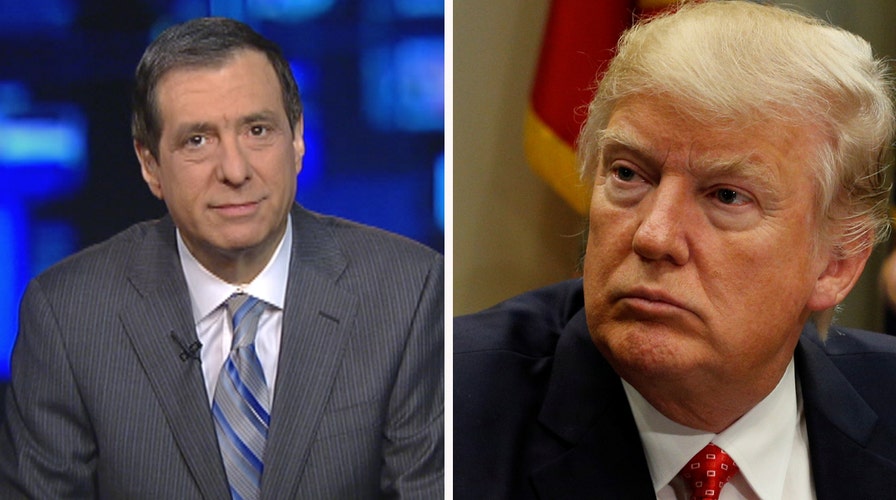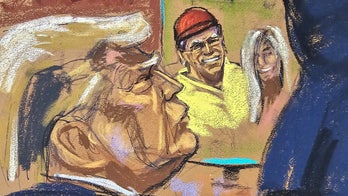Kurtz: President attacks media ‘fiction’
'MediaBuzz' host Howard Kurtz weighs in on the ongoing feud between President Trump and the media
Day after day, on issue after issue, President Trump is stepping up his attacks on the media.
His lambasting of what he calls the “failing New York Times” has become a constant refrain on his Twitter feed, even edging out “fake news” CNN.
But as these battles consume more and more bandwidth—the media, of course, love to talk about themselves—this question emerges: Is this helping Trump push through his agenda?
Does the president’s signature counterpunching move the needle on the temporary immigration ban, replacing ObamaCare, cutting tax cuts and boosting infrastructure spending?
Or is it in danger of becoming background noise?
In a matter of days, Trump has called a Times report on staff turmoil “fiction,” lambasted “fake news” polls by CNN, NBC and ABC, and said the media are deliberately downplaying some terror attacks.
Just to be clear: The president and his people have every right to push back on what they view as unfair or inaccurate reporting. The Washington Post, as I reported, had to back off from a story claiming that Steve Bannon had marched over to Homeland Security and pressured its secretary into not issuing exemptions to the travel ban.
The Times especially gets under the president’s skin as his hometown paper, and his post-election praise of the paper as a “jewel” when he went to the newsroom is now a distant memory.
The NYT piece that drew the president’s ire said he and his team are “rethinking an improvisational approach to governing that mirrors his chaotic presidential campaign,” especially after the “bungled rollout” of the executive order on immigration.
On a more personal level, the story portrayed Trump as “cloistered” in the White House, lonely and isolated, watching too much TV, and wandering around at night in a bathrobe.
When Sean Spicer assailed the story as “riddled with inaccuracies and lies” and “literally the epitome of fake news,” he declared that “I don’t think the president owns a bathrobe, he definitely doesn’t wear one.” Good to know!
Spicer also denied that Trump wasn’t fully briefed on an order reorganizing the National Security Council and making Bannon a member. The paper says it stands by the story.
"The failing @nytimes writes total fiction concerning me. They have gotten it wrong for two years, and now are making up stories & sources!"
Well, it wasn’t exactly fiction, since Spicer, Bannon, Chris Christie and others were quoted on the record. Trump attacked the paper again after one of the story’s authors, Maggie Haberman, appeared on CNN.
A number of news outlets have reported on staff infighting and Bannon’s considerable influence, but the Times, as Trump knows, is uniquely influential in setting the media agenda. Politico framed the reaction this way: “President Donald Trump on Monday lashed out via Twitter at a series of news reports revealing the turmoil inside the White House, leaning on his crutch of ‘fake news’ as he struggles to control a hardening narrative about a dysfunctional West Wing.”
Meanwhile, the president’s comments on the media and terrorism have set off another major skirmish.
After tweeting against the “so-called judge” who has temporarily blocked his travel ban, Trump spoke about ISIS at U.S. Central Command in Tampa: “You’ve seen what happened in Paris and Nice. All over Europe it’s happening. It’s gotten to a point where it’s not even being reported. And in many cases, the very, very dishonest press doesn’t want to report it. They have their reasons and you understand that.”
The Washington Post offered this take: “President Trump appears to be laying the groundwork to preemptively shift blame for any future terrorist attack on U.S. soil from his administration to the federal judiciary, as well as to the media… The president accused the media of failing to report on some terrorist attacks for what he implied were nefarious reasons."
I was puzzled by Trump’s accusation. When a reporter asked about it at a photo op yesterday, the president said: “I understand the total dishonesty of the media better than anybody – I let people know.” He did add that “not everybody” is in this category.
The White House put out a list of 78 terror attacks, but these included the carnage in Paris, Nice, San Bernardino and Orlando, which drew saturation coverage.
Now it’s true that some attacks overseas, without mass casualties, draw far less coverage than those committed on U.S. soil. And the media move on more quickly these days as these attacks, tragically, have become more commonplace.
But most attacks draw plenty of coverage as public interest and fear surges amid the carnage. And the networks pushed back, with CBS saying it covered 74 percent of the attacks on the list, NBC saying it covered 57, and Anderson Cooper and Bill Hemmer saying they were on the ground for some of them.
Trump feels strongly that he has to combat a relentlessly negative media narrative. But he also shines a powerful spotlight on the stories he most detests and brings them to a much wider audience.





